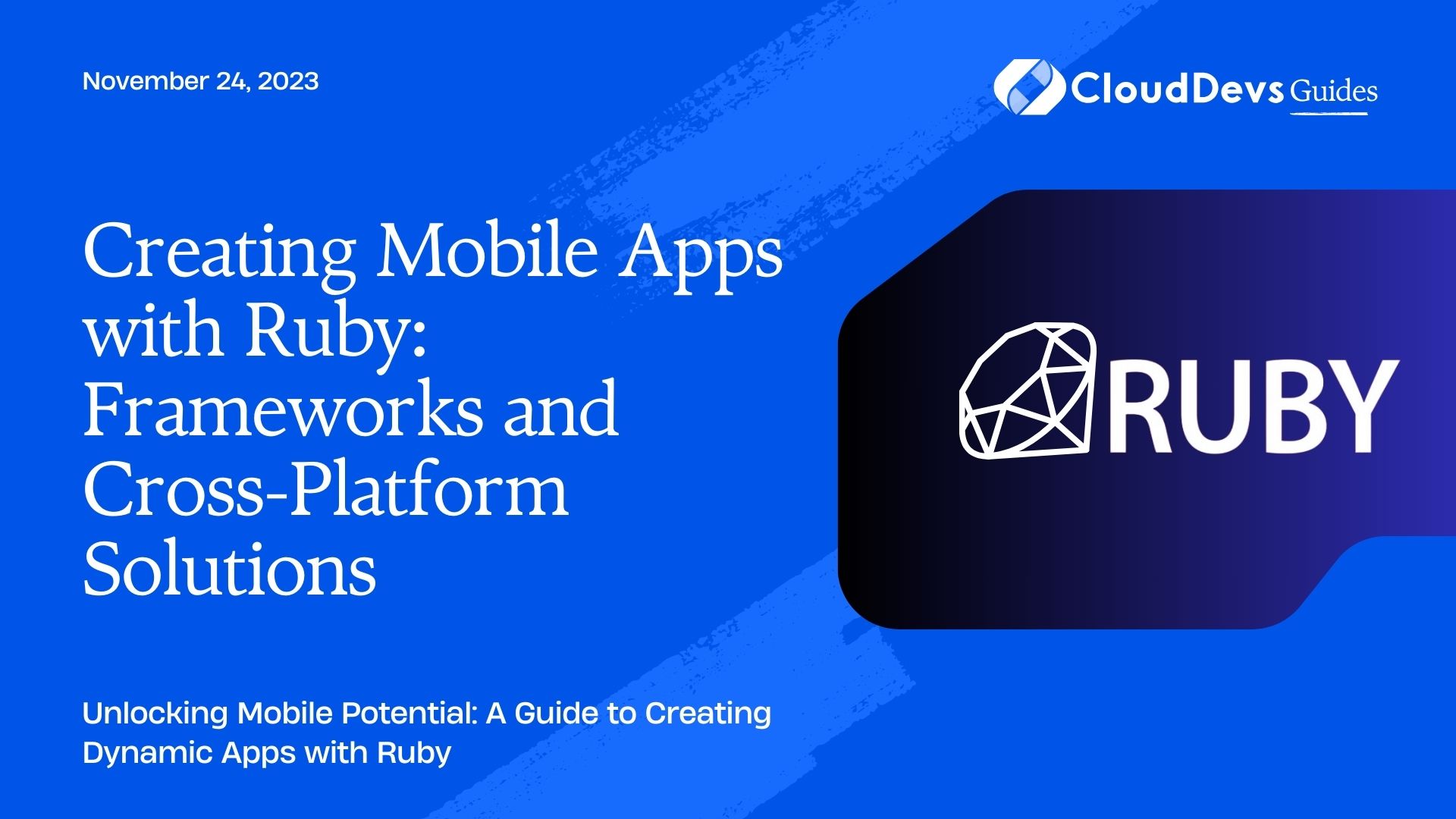How to build mobile apps with Ruby
Mobile app development has become a crucial aspect of the digital world, enabling businesses and individuals to connect with their audiences like never before. When it comes to choosing the right programming language for mobile app development, Ruby might not be the first one that comes to mind. However, thanks to the availability of various frameworks and cross-platform solutions, Ruby has found its way into the mobile app development landscape. In this article, we’ll delve into the realm of creating mobile apps with Ruby, exploring frameworks and cross-platform solutions that can help you streamline the development process.
Table of Contents
1. Why Choose Ruby for Mobile App Development?
Ruby is a dynamic, object-oriented programming language known for its simplicity and readability. While it gained popularity in web development, its versatility has led to its adoption in other domains, including mobile app development. Here are some reasons to consider Ruby for your mobile app endeavors:
- Familiar Syntax: If you’re already well-versed in Ruby, transitioning to mobile app development becomes smoother due to the consistent and elegant syntax.
- Developer Productivity: Ruby’s focus on developer happiness translates well to mobile app development. The language is designed to optimize developer productivity and satisfaction.
- Community and Resources: While not as mainstream as languages like Java or Swift for mobile app development, Ruby has an active community and ample resources to support your journey.
- Code Reusability: With the right frameworks, you can leverage your existing Ruby skills and codebase to create mobile apps without starting from scratch.
2. Ruby Frameworks for Mobile App Development
2.1. RubyMotion
RubyMotion is a versatile toolchain that allows you to write native mobile apps for iOS, Android, and macOS using Ruby. It combines the power of Ruby with native performance and functionality. Here’s a quick overview of how it works:
Installation:
bash gem install rubymotion
Creating a Project:
bash motion create MyMobileApp
RubyMotion provides a unified API to access platform-specific features, ensuring that your app feels native. This framework encourages code sharing between platforms, which can significantly reduce development time and effort.
2.2. Shoes
Shoes is a cross-platform toolkit for writing graphical apps in Ruby. While it’s not solely dedicated to mobile app development, it can be used to create simple mobile apps with a native feel. Shoes abstracts the underlying GUI libraries, allowing you to focus on functionality rather than platform intricacies.
Installation:
bash gem install shoes
Creating an App:
ruby
Shoes.app do
button("Click me") do
alert("Hello, Ruby Shoes!")
end
end
Shoes’ simplicity is ideal for small projects and prototypes, but it might not be suitable for complex, feature-rich mobile apps.
3. Cross-Platform Solutions
Building separate apps for different platforms can be time-consuming and resource-intensive. Cross-platform solutions aim to mitigate this challenge by enabling you to write code once and deploy it on multiple platforms.
3.1. Ruby on Rails with Web Views
Ruby on Rails, a popular web development framework, can be utilized for mobile app development by integrating web views. Web views allow you to display web content within your app, effectively creating a hybrid app.
Installation:
Add the webview gem to your Gemfile:
ruby gem 'webview'
Creating a Web View:
ruby
require 'webview'
Webview.create(title: "My Mobile App") do |webview|
webview.navigate("https://your-website.com/mobile")
end
While this approach enables code reuse between web and mobile platforms, it may not provide the same level of performance and native user experience as dedicated mobile frameworks.
3.2. Flutter with Ruby
Flutter, developed by Google, is a powerful UI toolkit that allows you to create natively compiled applications for mobile, web, and desktop from a single codebase. While Flutter itself is typically associated with Dart, you can explore using Ruby with Flutter using the “Ruby2Flutter” project.
3.2.1. Integration Steps:
- Install Flutter as per the official instructions.
- Set up the Ruby2Flutter project according to its documentation.
- Start creating Flutter UI components using Ruby syntax.
Using Ruby with Flutter might not be as straightforward as other options, but if you’re comfortable with Ruby and want to leverage the capabilities of Flutter, it’s worth exploring.
4. Best Practices for Ruby Mobile App Development
Creating mobile apps with Ruby involves more than just choosing a framework. Here are some best practices to keep in mind:
- Optimize Performance: While Ruby is known for its developer-friendly syntax, mobile apps require careful consideration of performance. Optimize critical parts of your code for better responsiveness.
- Utilize Native Components: Whenever possible, leverage native components to ensure that your app feels familiar and performs well on each platform.
- Responsive Design: Design your app with responsiveness in mind. Different devices and screen sizes should be accommodated seamlessly.
- Testing and QA: Rigorous testing is crucial for mobile app success. Ensure compatibility across various devices, screen orientations, and operating system versions.
- User Experience: Prioritize user experience. A well-designed and intuitive app can set you apart from the competition.
Conclusion
Ruby’s entrance into the realm of mobile app development opens up new possibilities for developers who are already comfortable with the language. With frameworks like RubyMotion and cross-platform solutions like Ruby2Flutter, you can harness the power of Ruby to create mobile apps that cater to diverse audiences. While choosing the right approach depends on factors such as your app’s complexity and performance requirements, Ruby undoubtedly offers a viable path to mobile app success. So, if you’re passionate about Ruby and mobile app development, it’s time to dive into the world of mobile app creation with Ruby.
Whether you’re a seasoned Ruby developer or just starting your coding journey, exploring mobile app development with Ruby can be an exciting endeavor. By leveraging the frameworks and cross-platform solutions mentioned in this article, you can embark on a journey to create innovative, user-friendly mobile apps that resonate with your target audience. So why wait? Start coding, testing, and bringing your mobile app ideas to life with the power of Ruby!
Table of Contents








